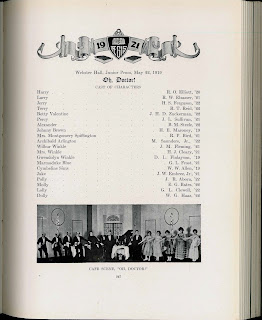 While looking for something else this morning, we stumbled across this provocative illustration from the 1921 yearbook, The Aegis. Wow, what does this say about students who were not athletes? It is easy to read a lot into this image, but it does demand some context.
While looking for something else this morning, we stumbled across this provocative illustration from the 1921 yearbook, The Aegis. Wow, what does this say about students who were not athletes? It is easy to read a lot into this image, but it does demand some context.Up until the 1920s the Dartmouth Players were an all male theater group (they began inviting women from other colleges to take the female roles later in the decade). On an all-male campus out in the "wilderness," cross dressing was not as uncommon as you might expect. Many of our student scrapbooks from the early part of the 20th century show pictures of male students camping it up in drag.
So, on one level, this is just a humorous depiction of one of the most important non-athletic extra-curricular activities on campus--the theater. On another level it is an example of the prevalent chauvinism of the era, one that was played out intensively on an all-male, elite campus. By that reading, if you are not an athlete your masculinity is in question.

